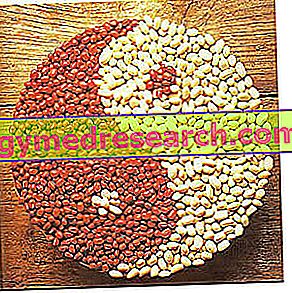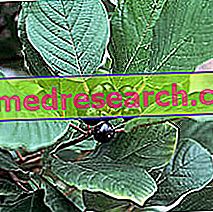DAONIL ® is a drug based on Glibenclamide
THERAPEUTIC GROUP: Oral hypoglycemic agents - Sulfonylureas
IndicationsAction mechanismStudies and clinical effectiveness Usage and dosage instructionsWarnings Pregnancy and lactationInteractionsContraindicationsUndesirable effects
Indications DAONIL ® - Glibenclamide
DAONIL ® is indicated as a pharmacological aid in the treatment of type II diabetes mellitus, in the event of failure of non-pharmacological therapeutic measures such as a balanced diet and a healthy lifestyle.
Mechanism of action DAONIL ® - Glibenclamide
The hypoglycemic action of DAONIL ® is due to the presence of its active ingredient glibenclamide, belonging to the pharmacological class of second generation sulfonylureas.
Taken orally, it reaches its maximum peak in 2-4 hours, then gradually decreases and is eliminated in the form of inactive metabolites both through feces and urine, while continuing to exercise its hypoglycemic effect for about 24 hours.
The main mechanism of action is at the level of pancreatic Beta cells, in which glibenclamide, penetrated through the plasma membrane, selectively inhibits the SUR1 potassium channel, facilitating the depolarization of the Beta cell and the consequent release of insulin.
Although the activity of insulin secretagogue is predominant, this sulfonylurea also presents a series of extrahepatic mechanisms useful for improving peripheral insulin sensitivity and at the same time reducing potentially deleterious processes for diabetic patients such as gluconeogenesis and hepatic glycogen lysis. to contribute to the onset of hypoglycemia.
Studies carried out and clinical efficacy
1. GLIBENCLAMIDE AND GLYCEMIA
This study is particularly important from the statistical point of view and shows how the intake of glibenclamide can guarantee the reduction of glycosylated hemoglobin from 8.7% to 7% in 3 months of therapy, guaranteeing better control of both postprandial and basal glycaemia.
2. GLIBENCLAMIDE AND GESTATIONAL DIABETES
Despite gestational diabetes, it is one of those diseases that are particularly dangerous for the health of the fetus and is present among the pregnant women with a frequency of about 3%, at the moment the only effective and safe therapeutic treatment, if well dosed, seems to be the one linked to the administration of insulin. The most important limit related to this type of therapeutic approach is represented by the low compliance among patients which reduces their effectiveness. For this reason, the use of oral hypoglycemic agents could be particularly useful, but at present the studies present in the literature seem to agree on the high danger to the health of the fetus.
3. GLIBENCLAMIDE / HONEY: ANTIOXIDANT ROLE
Different experimental studies have shown that the association between honey and glibenclamide can significantly increase the pull of antioxidants at the cellular level, preserving in some cases, even the beta cell from tissue damage. This important indication has been observed for the significant increase in endogenous antioxidants such as glutathione.
Method of use and dosage
DAONIL ® Glibenclamide 5 mg tablets:
DAONIL ® therapy should start with the minimum dose that can give the hypoglycemic effect, therefore equal to ½ tablet per day.
Only after monitoring the patient's blood sugar levels for at least a couple of weeks, the doctor can adequately correct the drug therapy, increasing the dosage up to a maximum of 2-3 tablets per day.
You should prefer to take it as a single dose, better know before the main meal with a large glass of water.
Warnings DAONIL ® - Glibenclamide
In order for DAONIL ® to be able to guarantee the achievement and maintenance of the therapeutic target, non-pharmacological therapeutic measures such as a healthy diet and a correct lifestyle are of fundamental importance.
In fact, it is important to reiterate that the management of the diabetic disease cannot ignore the improvement of daily habits.
During the whole therapeutic procedure it is important to constantly monitor the glycemic levels to avoid the appearance of metabolic alterations, potentially dangerous for the patient's health, thus adapting both the drug therapy and the eating habits.
The possible appearance of hypoglycemia, preceded by the presence of premonitory symptoms, could be controlled by the rapid administration of oral glucose.
Administration of glibenclamide in patients with impaired hepatic and renal function, or with G6PD enzyme deficiency should be avoided in order to prevent the development of adverse reactions such as pronounced hemolysis.
The presence of lactose in DAONIL ® could determine the appearance of gastro-intestinal disorders in patients with lactase enzyme deficiency or glucose / galactose malabsorption.
It is also essential to remember that among the manifestations of hypoglycemia there is the reduction of the patient's perceptive abilities which could make the use of machinery or driving vehicles dangerous.
PREGNANCY AND BREASTFEEDING
Gestational diabetes, which affects about 3% of pregnant women, is a transient pathological condition characterized by hyperglycemia that could seriously compromise the health of the fetus.
Despite the therapeutic efficacy of glibenclamide, several studies have shown the toxic effects of this active ingredient on the health of the fetus, so much so as to severely contraindicate the administration of DAONIL ® during the period of pregnancy.
Furthermore, the possible secretion of the active ingredient in breast milk could also expose the infant to the risk of hypoglycemia, therefore it is not recommended to stop breast-feeding during this therapy or to avoid the use of glibenclamide as a hypoglycemic agent.
Interactions
Given the hepatic metabolism of glibenclamide and its numerous metabolic interrelations, it is possible to describe numerous interactions capable of altering the normal pharmacokinetic properties of the active principle and the related therapeutic capacities.
More precisely, an enhancement of the hypoglycemic effect could occur following the simultaneous intake of insulin and other oral antidiabetic agents, ACE inhibitors, anabolic steroids and male sex hormones, chloramphenicol, coumarin derivatives, cyclophosphamide, disopyramide, fenfluramine, pheniramidol, fibrates, fluoxetine, ifosfamide, MAO inhibitors, miconazole, para-aminosalicylic acid, pentoxifylline (parenteral with high doses), phenylbutazone, azapropazone, oxyphenbutazone, probenecid, quinolonics, salicylates, sulfinpyrazone, sulfonamides, sympatholytic drugs such as beta-blockers and guanethidine, clarithromycin, tetracycline, tritoqualine, trophosphamide, thus increasing the risk of hypoglycemia.
On the contrary the therapeutic efficacy of DAONIL ® could be reduced following the intake of acetazolamide, barbiturates, corticosteroids, diazoxide, diuretics, adrenaline and other sympathomimetic drugs, glucagon, laxatives (after prolonged use), nicotinic acid (at high doses), estrogens and progestins, phenothiazines, phenytoin, thyroid hormones and rifampicin.
Glibenclamide could also increase the plasma concentrations of ciclosporin, significantly increasing its toxicity.
Contraindications DAONIL ® - Glibenclamide
DAONIL ® is contraindicated in patients suffering from type 1 diabetes mellitus, severe hepatic and renal dysfunction, diabetic precoma and coma, keto diabetic acidosis and in case of hypersensitivity to the active substance or to one of its excipients.
This medicine is also contraindicated during pregnancy and lactation.
Undesirable effects - Side effects
Although sulfonylurea therapy is well tolerated in most patients, the risk of hypoglycemia is certainly the potentially most dangerous side effect of DAONIL ® therapy. This condition can occur with headache, nausea, vomiting, bradycardia, fatigue, dyspnoea, visual disturbances and tremors, is usually associated with incorrect dosage formulation or inadequate diet, too low in carbohydrates.
Gatro-intestinal disorders, alterations in the blood picture with diffuse cytopenia and skin reactions due to hypersensitivity to the active ingredient or its excipients have been observed only in rare cases, without clinically relevant consequences for the patient's health.
Note
DAONIL ® can only be sold under strict medical prescription.



